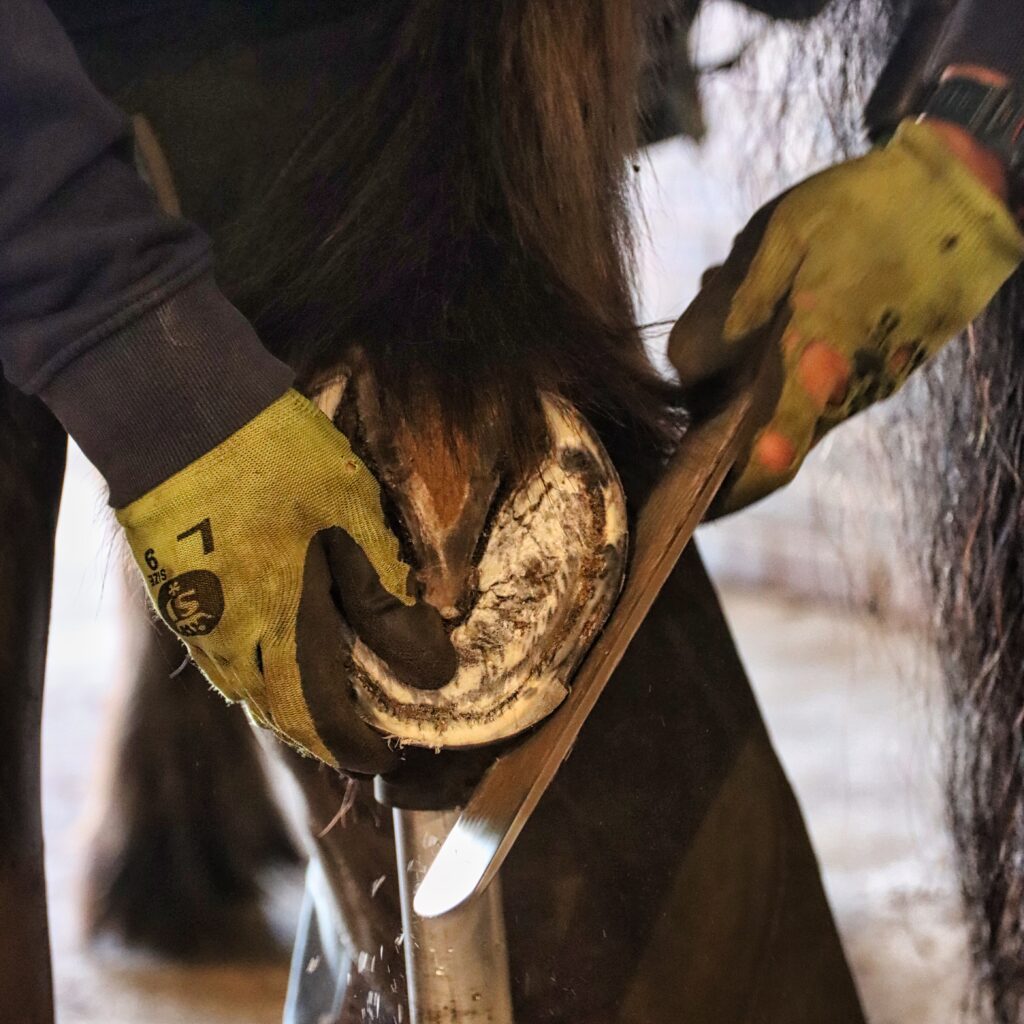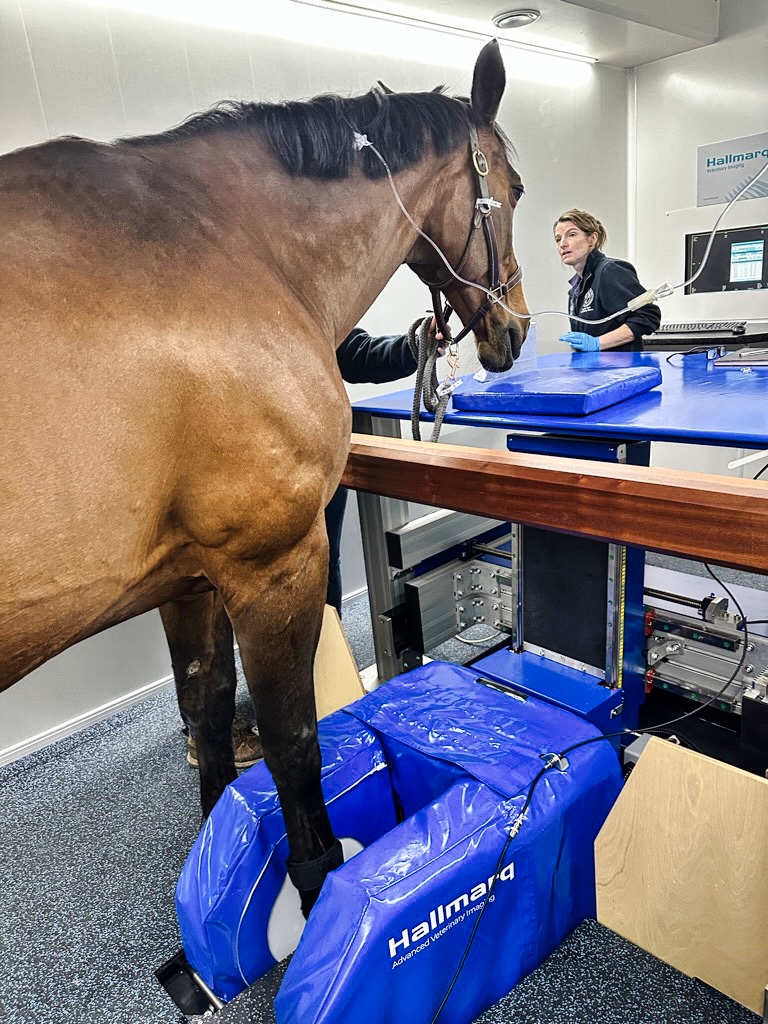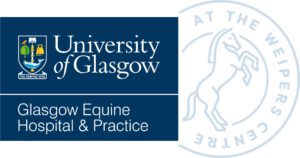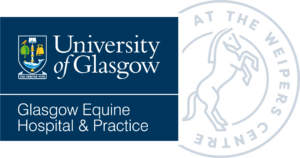Investigating Equine Forelimb Lameness:
A Study of Foot Balance and Corrective Farriery Using MRI
A collaborative project at Glasgow Equine Hospital investigating how corrective farriery affects forelimb lameness.
Can farriery help prevent and resolve subtle lameness? We're investigating.
Watch a short video to learn about the study and how you or your clients can take part
Participating in this study includes three MRI scans – two of which are provided free of charge. Helping your horse, while contributing to vital research.
Understanding Lameness Through Farriery and Imaging
Lameness is a common issue in horses, and while X-rays are helpful for identifying problems in the bones, many causes lie in the other internal parts of the foot. These include ligaments, tendons, and cartilage – collectively known as soft tissue structures – which are not visible on standard imaging.
This research study, based at Glasgow Equine Hospital, is using standing MRI and gait analysis to explore how corrective farriery – particularly spiral shoeing – affects hoof balance and the health of these soft tissue structures.
The study is led by our clinical team in collaboration with highly experienced farrier Jim Ferrie.
Why This Research Matters
- Lameness is can be caused by hoof imbalance, but not all causes are visible on X-ray.
MRI allows us to see soft tissues like ligaments and cartilage inside the hoof.
Farriery is widely used to treat imbalance, but there’s limited research into its effect on internal foot structures.
This study aims to provide scientific data to support treatment decisions for vets and farriers.
From Assessment to Imaging – A Step-by-Step Overview
Initial assessment – Your horse is examined for lameness, including a clinical evaluation and gait analysis. This helps determine whether foot imbalance may be a contributing factor.
Eligibility check – If foot imbalance appears to be the cause, your horse may be invited to join the study.
Baseline MRI – You’ll pay for the initial standing MRI, which gives us a detailed picture of the hoof’s internal structures.
Corrective farriery – The horse receives spiral shoeing over three shoeing cycles (typically every 4–5 weeks) at Glasgow Equine Hospital, Weipers Centre.
Follow-up appointment after shoeing – After the three cycles, your horse returns for a second evaluation. This includes a repeat lameness assessment, gait analysis, and a second MRI – all provided free of charge.
One-year follow-up – Your horse returns approximately 12 months after the initial assessment for a third MRI, another lameness evaluation, and gait analysis – again free of charge. This helps us assess longer-term outcomes.
Can My Horse Take Part?
We are currently inviting participation from:
Horse owners whose horses are experiencing forelimb lameness.
Vets or farriers who suspect hoof imbalance is involved.
If you’re unsure, our team is happy to help assess suitability.
Participating in this study not only gives your horse access to a detailed diagnostic process and expert farriery, it also includes financial benefits:
The second MRI scan is provided free of charge, helping us track progress and giving you valuable insight into how your horse is responding to treatment.
You and your vet receive a detailed assessment of your horse’s lameness and gait as part of our standard clinical care.
By taking part, you’re helping your own horse receive tailored care — and contributing to the future of equine lameness treatment.
Recruitment is open until January 2026, or until all places are filled.
Costs - Understanding the Value of Participation
Understanding the Value of Participation
Here is a typical pricing guide for similar assessments carried out independently of the study:
Surgery consultation and initial investigation (including nerve block and 2x radiographs): £424
Initial MRI (includes overnight stay, sedation, metal check): £1,200
Repeat lameness exam: £115
Second MRI (re-scan): £650
Specialist farriery (3 shoeings): £600
Third MRI (1-year follow-up): £650
Estimated total cost independently: £3,645
Study Package Cost: £1,800
Taking part in the study could represent a saving of up to £1,845.
Please note that prices may vary depending on case complexity and individual needs (i.e. further investigation, imaging or treatments outside of the study parameters)
What If My Horse Doesn’t Improve?
Understanding Expectations and Ongoing Care
The study has been carefully designed to include only those horses where foot imbalance appears to be a likely contributor to lameness. However, being enrolled in the study does not guarantee full resolution of lameness or a specific outcome.
At each consultation, your horse’s progress will be assessed through gait analysis, repeat lameness evaluation, and MRI imaging. If your horse is not responding as expected, we will discuss whether it is appropriate to continue in the study or explore alternative diagnostic or treatment options.
As with most medical and veterinary treatments, outcomes will vary from horse to horse. While many horses improve, not all will return to full soundness — and your vet will guide you through additional choices if necessary.
What Does MRI involve?
- The MRI is carried out while the horse is standing and lightly sedated.
It is minimally invasive and does not require general anaesthesia.
The scan takes around 60–90 minutes.
The procedure is designed to be as safe and stress-free as possible for horses and handlers.
Lead by Professionals
Josie Bennett
Junior Clinician & Study Lead
Josie oversees recruitment and coordination of cases, working directly with owners, vets and farriers.
Jim Ferrie FWCF (HonAssocRCVS) – One of the only Associate Members of the RCVS who is a farrier and an Honorary Associate of the University of Glasgow, with over 40 years’ experience in corrective and remedial farriery.
Graham McBurney – Highly experienced farrier who regularly works on complex corrective cases referred to Glasgow Equine Hospital. He brings deep practical expertise to the collaborative care team.
Nicholas Bellito – Senior equine surgeon at Glasgow Equine Hospital with expertise in orthopaedics and advanced imaging.
Professor Patrick Pollock
Equine Surgeon, Head of Hospital
Patrick brings clinical expertise and guidance in orthopaedic, surgical and diagnostic imaging aspects of the study.

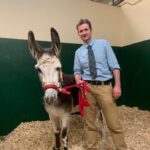
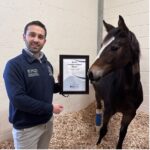
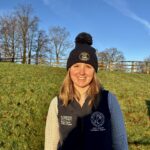
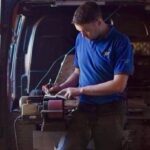
Want to Know More?
If you have a horse that may be suitable, or you’d like to learn more about the research, please contact us.
Email: vet-equine@glasgow.ac.uk
You can also follow updates and findings on our Facebook page
